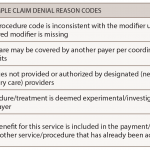
Frederic Muller/shutterstock.com
As the year draws to a close, it is vital to pay close attention to your practice’s revenue cycle to maintain an operational and financially healthy business. Operational aspects should be a top priority, with careful monitoring as they relate to efficiency in receivables and denials management.
Healthcare revenue cycle management is the strategy that healthcare organizations use to manage claim submissions and pay the bills. It involves the financial aspect of the administrative and clinical functions associated with claims processing, payment and revenue generation, which covers the identification, management and collection of patient service revenue.
Healthcare revenue cycle management begins at the time a patient makes an appointment, and continues to the point when there is a zero balance on the patient’s account. Coding and billing is a multi-faceted area not limited to the back-end function of the practice. Front-end tasks play an important role in driving revenue management. Tasks related to charge capturing, claims submission, processing payment statements and managing all denials are critical steps. The extent to which your practice has a handle on these key areas directly affects the practice revenue stream, because the goal is to reconcile the account balance expediently.
Building a healthy bottom line is necessary to reduce the portion of your revenue that is lingering in your accounts receivable (A/R). The four steps to achieve a more efficient revenue cycle in the practice involve workflow, use of technology, qualified team members and communication.
Workflow
Tasks related to service billing are key activities in the revenue cycle workflow. Ongoing tasks, such as verifying insurance, collecting co-pays, coding appropriate diagnosis and procedure codes, submitting claims and managing payments/collections, are all linked in achieving a streamlined workflow. Even one small kink in the process can affect the revenue cycle and create chaos.
All the information necessary to complete each task for all patient encounters must be captured. To keep the workflow revenue cycle running smoothly, each practice area should focus on the following steps for a successful daily operation:
Step 1—Front Office
- Pull the daily schedule and charts in advance of the patients’ arrivals;
- Always verify patient information upon check-in; for established patients, verify and update patient and insurance information as needed; for new patients, collect all necessary data and prepare the patient chart;
- Validate insurance eligibility;
- Complete all patient HIPAA compliance; and
- Collect any co-pays and resolve any outstanding balances for established patients.
Step 2—Medical Assistants, Labs Technicians and Nurses
- Review charts and escort patient to exam room;
- Complete patient intake and vitals (collect as much information as necessary); and
- Complete any necessary labs for that visit.
Step 3—Physicians, NPs and PAs
- Complete patient history and exam;
- Make sure documentation in the medical record is thorough; and
- Discharge patient.
Step 4—Billing and Coding
- Review chart sheet thoroughly (ICD, CPT, modifiers and HCPCS); and
- Finalize and submit clean claims.
Step 5—Claims Processing
- Process payments and clear account;
- Denials received should be handled immediately:
- Review chart;
- Request appeal;
- Resubmit claim; and
- Monitor appeal decision and proceed accordingly (if payment is received, reconcile account; if service is denied and the patient is responsible, mail the patient a statement).
Technology Use
The use of technology has been embraced by most physician practices as an integral part of office efficiency and productivity. Practice management systems and standard electronic transactions can speed up the claim processes and save your practice time and money. Receiving electronic remittance advice (ERA) and electronic funds transfers (EFTs) for claims payment can be much faster than using traditional mail and helps with keeping the revenue cycle current.


